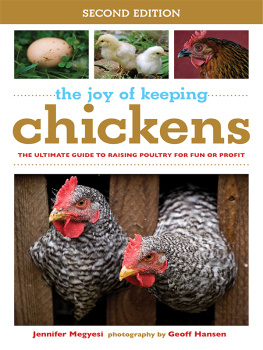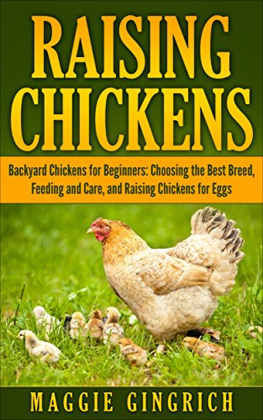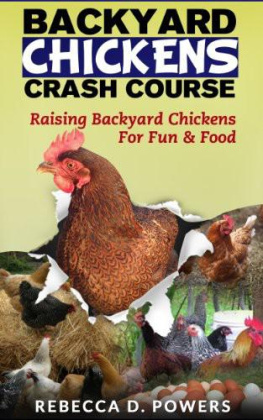Copyright 2009, 2015 by Jennifer Megyesi
Photography copyright 2009, 2015 by Geoff Hansen
All rights reserved. No part of this book may be reproduced in any manner without the express written consent of the publisher, except in the case of brief excerpts in critical reviews or articles. All inquiries should be addressed to Skyhorse Publishing, 307 West 36th Street, 11th Floor, New York, NY 10018.
Skyhorse Publishing books may be purchased in bulk at special discounts for sales promotion, corporate gifts, fund-raising, or educational purposes. Special editions can also be created to specifications. For details, contact the Special Sales Department, Skyhorse Publishing, 307 West 36th Street, 11th Floor, New York, NY 10018 or .
Skyhorse and Skyhorse Publishing are registered trademarks of Skyhorse Publishing, Inc., a Delaware corporation.
Visit our website at www.skyhorsepublishing.com.
10 9 8 7 6 5 4 3 2 1
Library of Congress Cataloging-in-Publication Data
Megyesi, Jennifer Lynn, 1963
The joy of keeping chickens : the ultimate guide to raising poultry for fun or profit / Jennifer Megyesi ; photography by Geoff Hansen.
p. cm.
Includes bibliographical references and index.
1. Chickens. 2. Poultry farms. I. Title.
SF487.M42 2009
636.5dc22
2008047797
Cover design by LeAnna Weller Smith
Print ISBN: 978-1-63220-467-7
Ebook ISBN: 978-1-63450-026-5
Printed in China
For Bradford , who at eight months, pointed up to the dark sky outside the farmhouse and muttered in baby breath, Moon, and who I know will reach for and capture the stars.

Peggy, a Polish Crested hen, basks in early sunlight at Fat Rooster Farm in Royalton, Vermont.
CONTENTS











I like chickens because:
#1. I like eating eggs.
#2. I like holding chicks.
#3. I like feeding chickens.
#4. I like collecting chicken eggs.
#5. I like washing chicken eggs.
Bradford Jones, age nine
preface
The Joy of Keeping Chickens
FOR TWO WEEKS NOW, I have been unable to come up with a format to begin my talk about the joy of keeping chickens. Its a topic that I have been invited to present at the childrens conference at the annual Northeastern Organic Farming Association meeting in Randolph, Vermont (NOFA-VT). This year, the conference, with its ever-growing popularity, has stretched into a two-day affair, and I have been asked to provide a one-hour presentation about chickens for children.
This seems like a no-brainer, for someone who has raised chickens almost her whole life, for someone who is commonly, and kindly, referred to as the crazy chicken lady.
But now, I have angst. What will this audience gain from my talk? They range from six to twelve years in age, and some may already know a lot about raising chickens.
I make up a list of questions, a quiz for them to take, about who lays eggs, and who crows good morning. Then I remember that they are children, and filling out forms and taking tests are chores done best at school, not in fun forums at an educational conference.
So I pack up Henry, the 10-pound Barred Plymouth Rock rooster, who boards with us annually because his Vermont summer parents have no safe winter haven for him to stay in while they travel to warmer climes. Also packed are Danny and Margaret Suzanne (Peggy Sue, for short), the Polish Cresteds, who can barely see through their headdresses of scattered, wild feathers that make them look like voodoo dolls. Then there are the pair of Old English Game Bantams, proud and glittering with their emerald-black feathers. There are my two prized White Silkies, whose sole existence on the farm is just for sheer grin in the morning at seeing their fur-like plumage while I rush around doing the rest of the barn chores. Silkies dont lay many eggs, and their black-skinned bodies put off the best of cooks unless they specialize in cooking broiled Chinese black fowl. Last, but not least, I add a Russian Orhloff, not yet recognized by our own American Poultry Association, but beautiful and worth showing off anyway.
The cages are covered with blankets on this cold, bleak February day; these birds have spent a pampered winter in a tight barn that never goes below freezing and stays as humid as a day spa. They are packed like sardines into crates in the back of the truck, but by the time we reach the conference, the Silkies have found their freedom, bouncing around in the back of the truck, looking for a way out of fame.
As I unload the crates, I begin to formulate the final parts of my presentation. The blankets will stay over the cages to draw the children to the talk. At the very last moment, I will pluck Henry and the two docile Silkies from their cages and plop them onto the tarp that has been spread to catch their inevitable offerings.
Henrys presence draws even the adults. Children, some of these weighing no more than three times what he does, take turns picking him up and cradling him like a doll. The Silkies are cooed at. The Old English are rocked into submission and fed vast amounts of grain so that everyone is astonished at the burgeoning size of their stomachs. Danny and Peggy Sue are gawked at, each becoming a little self-conscious in the end, so I eventually retire them to their cages.
Then a wonderful thing happens. The children forget that I am there, and they pair off with their respective chickens. They swap stories of chickens that they have had, or they wonder together at the feel of a Silkies feathers and the warmth of Henrys toothed comb. They pet the chickens, talk to them, and offer them water and food. There are chicken kisses and hugs and chickenhuman dialog. And while I talk about how chickens sweat, and who lays eggs, and who does the barnyard crowing, its the joy of keeping chickens taking over, and really I havent needed to stress out about a thing.
























